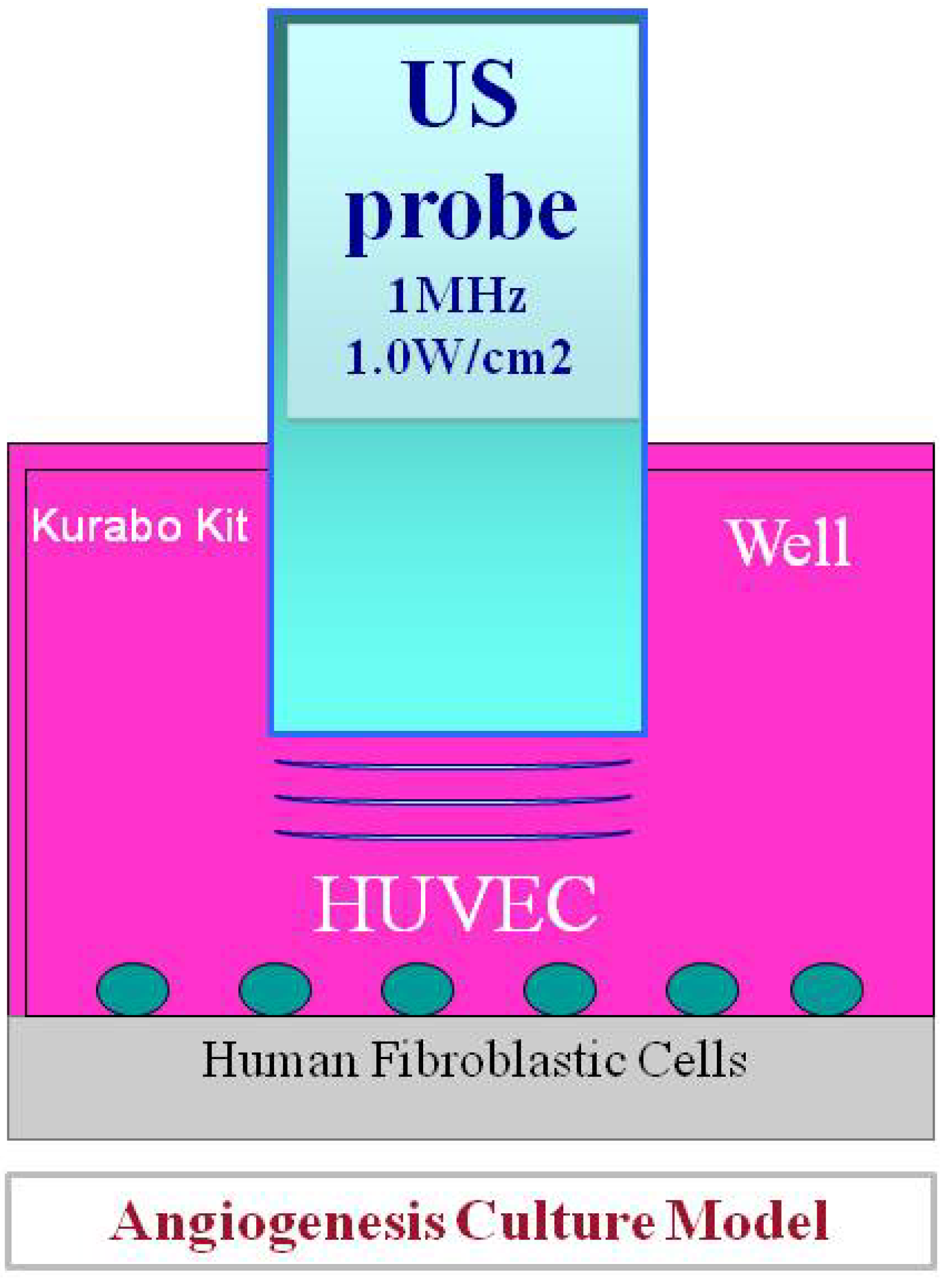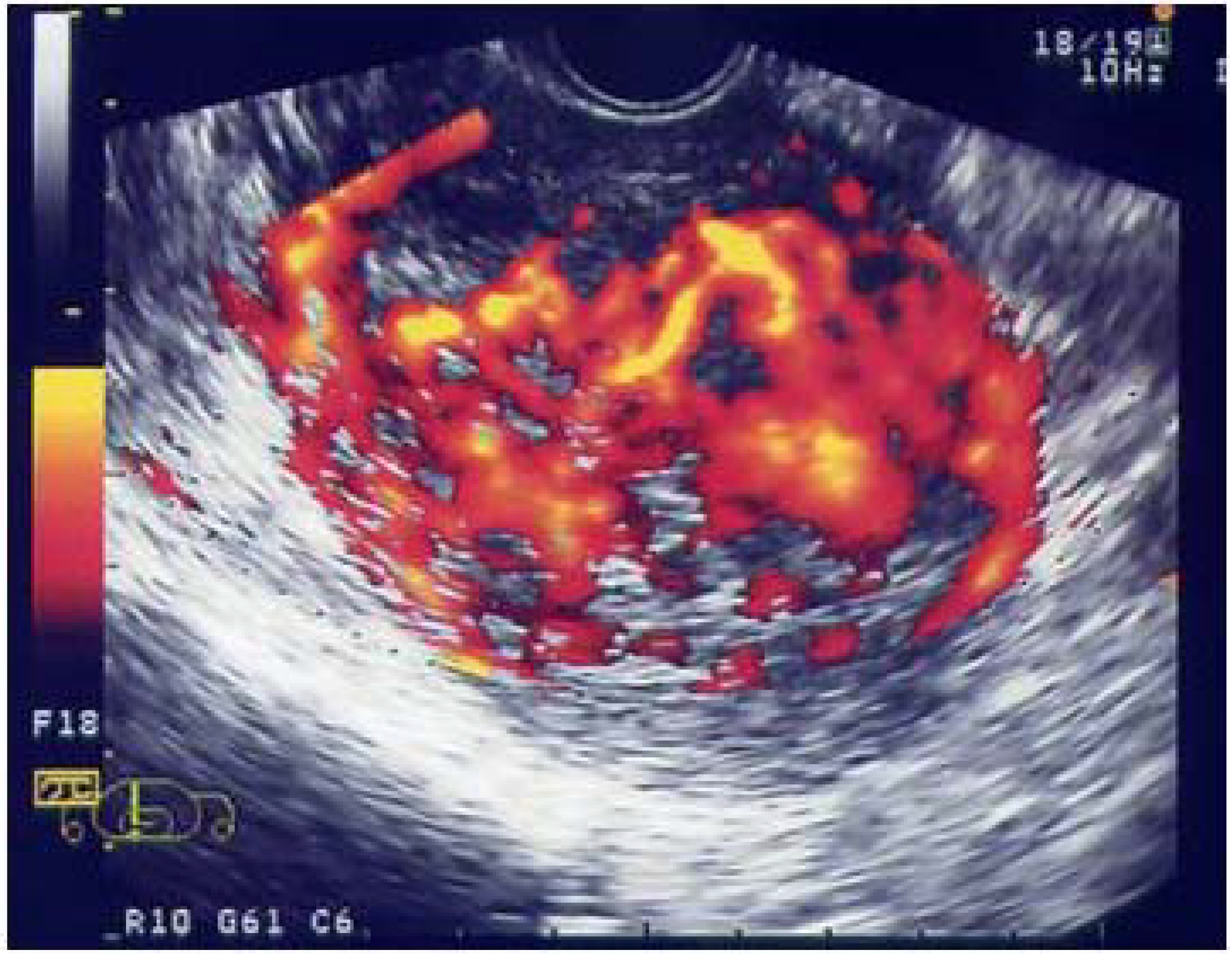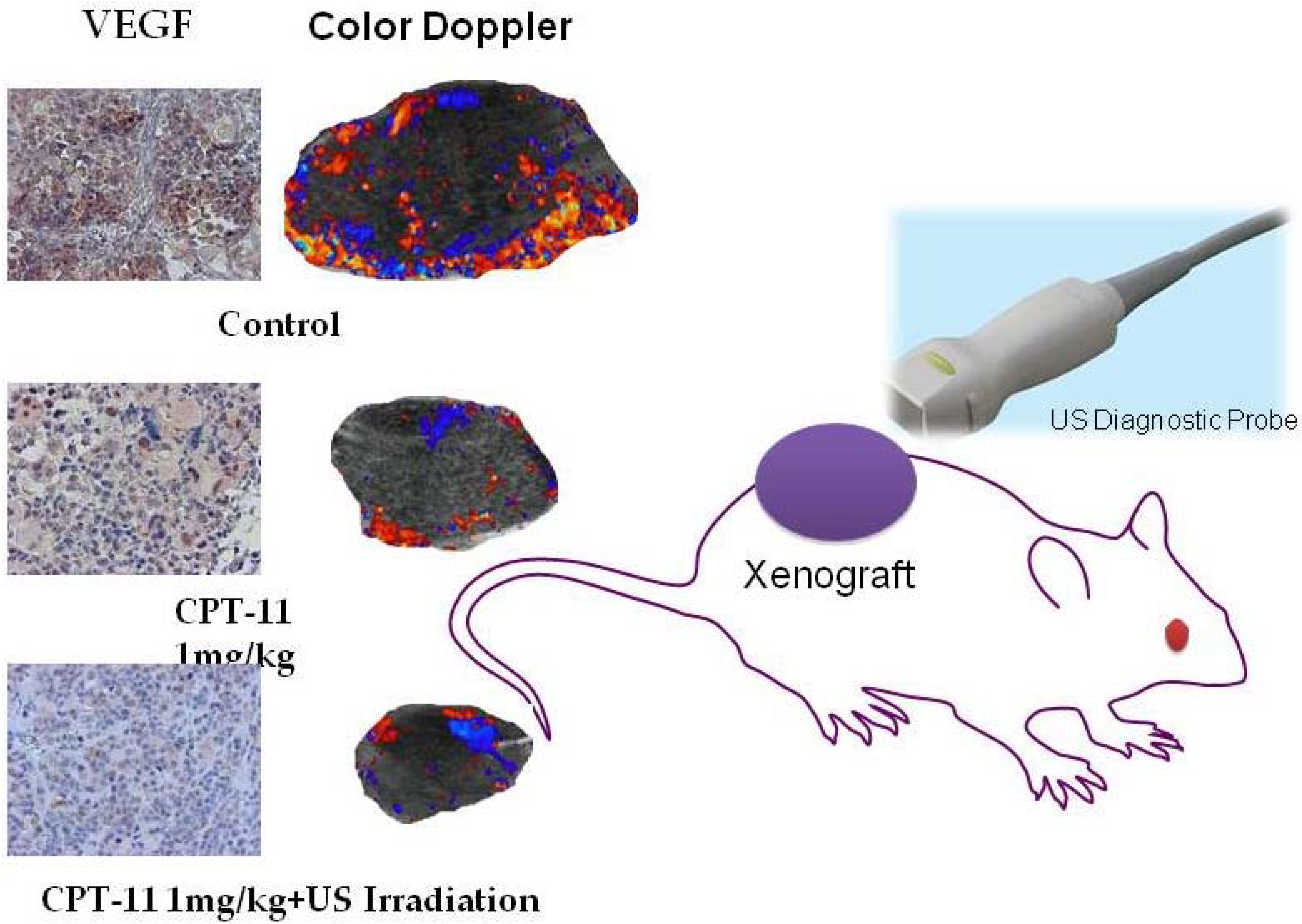Development of a Cancer Treatment with the Concomitant Use of Low-Intensity Ultrasound: Entering the Age of Simultaneous Diagnosis and Treatment
Abstract
:1. Introduction
2. Biological Effects of Low-Intensity Ultrasound

3. Anti-Angiogenesis for Cancer and Mobilization Suppression of Circulating Endothelial Cells in the Bone Marrow

4. Proper Drug Dosage Method in Ultrasound Cancer Treatment
5. Evaluation of the Inhibitory Effect of Angiogenesis by Color Doppler Ultrasound Imaging

6. Future of Low-Intensity Ultrasound Treatment: Entering the Age of Simultaneous Diagnosis and Treatment
7. In Preparation for Ultrasound Treatment of Uterine Cancer
8. Drug Delivery System and Microbubbles and Nanobubbles
9. Conclusions
Conflicts of Interest
References
- Suslick, K.K. Sonochemistry. Science 1990, 247, 1439–1445. [Google Scholar] [CrossRef] [PubMed]
- Feril, L.B., Jr.; Kondo, T. Biological effects of low intensity ultrasound: The mechanism involved, and its implications on therapy and on biosafety of ultrasound. J. Radiat. Res. 2004, 45, 479–489. [Google Scholar] [CrossRef]
- Lejbkowicz, F.; Zwiran, M.; Salzberg, S. The response of normal and malignant cells to ultrasound in vitro. Ultrasound Med. Biol. 1993, 19, 75–82. [Google Scholar] [CrossRef]
- Tachibana, K.; Uchida, T.; Ogawa, K.; Yamashita, N.; Tamura, K. Induction of cell-membrane porosity by ultrasound. Lancet 1999, 353, 1409. [Google Scholar] [PubMed]
- Kremkau, F.W.; Kaufmann, J.S.; Walker, M.M.; Burch, P.G.; Spurr, C.L. Ultrasonic enhancement of nitrogen mustard cytotoxicity in mouse leukemia. Cancer 1976, 37, 1643–1647. [Google Scholar] [CrossRef]
- Yumita, N.; Nishigaki, R.; Umemura, R. Sonodynamically induced antitumor effect of Photofrin II on colon 26 carcinoma. J. Cancer Res. Clin. Oncol. 2000, 126, 601–606. [Google Scholar] [CrossRef]
- Yoshida, T.; Kondo, T.; Ogawa, R.; Feril, L.B., Jr.; Zao, Q.L.; Watanabe, A.; Tsukada, K. Combination of doxorubicin and low-intensity ultrasound causes a synergistic enhancement in cell killing and an additive enhancement in apoptosis induction in human lymphoma U937 cells. Cancer Chemother. Pharmacol. 2008, 61, 559–567. [Google Scholar] [CrossRef]
- Emoto, M.; Tachibana, K.; Iwasaki, H.; Kawarabayashi, T. Antitumor Effect of TNP-470, an angiogenesis inhibitor, combined with ultrasound irradiation for human uterine sarcoma xenografts evaluated by contrast color Doppler ultrasound. Cancer Sci. 2007, 98, 929–935. [Google Scholar] [CrossRef]
- Choijamts, B.; Naganuma, Y.; Nakajima, K.; Kawarabayashi, T.; Miyamoto, S.; Tachibana, K.; Emoto, M. Metronomic irinotecan chemotherapy combined with ultrasound irradiation for a human uterine sarcoma xenograft. Cancer Sci. 2011, 102, 452–459. [Google Scholar] [CrossRef]
- Lagneaux, L.; de Meulenaer, E.C.; Delforge, A.; Dejeneffe, M.; Massy, M.; Moerman, C.; Hannecart, B.; Canivet, Y.; Lepeltier, M.F.; Bron, D. Ultrasonic low-energy treatment: A novel approach to induce apoptosis in human leukemic cells. Exp. Hematol. 2002, 30, 1293–1301. [Google Scholar] [CrossRef] [PubMed]
- Zhou, S.; Schmelz, A.; Seufferlein, T.; Li, Y.; Zhao, J.; Bachem, M.G. Molecular mechanisms of low intensity pulsed ultrasound in human skin fibroblasts. J. Biol. Chem. 2004, 279, 54463–54469. [Google Scholar] [CrossRef] [PubMed]
- Bandow, K.; Nishikawa, Y.; Ohnishi, T.; Kakimoto, K.; Soejima, K.; Iwabuchi, S.; Kuroe, K.; Matsuguchi, T. Low-intensity pulsed ultrasound (LIPUS) induces RANKL, MCP-1, and MIP-1beta expression in osteoblasts through the angiotensin II type 1 receptor. J. Cell Physiol. 2007, 211, 392–398. [Google Scholar] [CrossRef]
- Tabuchi, Y.; Ando, H.; Takasaki, I.; Feril, L.B., Jr.; Zhao, Q.L.; Ogawa, R.; Kudo, N.; Tachibana, K.; Kondo, T. Identification of genes responsive to low intensity pulsed ultrasound in a human leukemia cell line Molt-4. Cancer Lett. 2007, 246, 149–156. [Google Scholar] [CrossRef]
- Folkman, J. Angiogenesis in cancer, vascular, rheumatoid and other disease. Nat. Med. 1995, 1, 27–31. [Google Scholar] [CrossRef]
- Emoto, M.; Iwasaki, H.; Ishiguro, M.; Kikuchi, M.; Horiuchi, S.; Saito, T.; Tsukamoto, N.; Kawarabayashi, T. Angiogenesis in carcinosarcomas of the uterus: Differences in the microvessel density and expression of vascular endothelial growth factor between the epithelial and mesenchymal elements. Hum. Pathol. 1999, 30, 1232–1241. [Google Scholar] [CrossRef]
- Emoto, M.; Udo, T.; Kubota, M.; Ishiguro, M.; Iwasaki, H.; Kikuchi, M.; Kawarabayashi, T. Neovascularization of uterine carcinosarcoma: A report of two cases analyzed by color Doppler ultrasound and microvessel density. J. Ultrasound Med. 1999, 18, 315–319. [Google Scholar] [PubMed]
- Naganuma, Y.; Choijamts, B.; Shirota, K.; Nakajima, K.; Ogata, S.; Miyamoto, S.; Kawarabayashi, T.; Emoto, M. Metronomic doxifluridine chemotherapy combined with the anti-angiogenic agent TNP-470 inhibits the growth of human uterine carcinosarcoma xenografts. Cancer Sci. 2011, 102, 1545–1552. [Google Scholar] [CrossRef]
- Emoto, M.; Iwasaki, H.; Oshima, K.; Kikuchi, M.; Kaneko, Y.; Kawarabayashi, T. Characteristics of rhabdomyosarcoma cell lines derived from uterine carcinosarcomas. Virchow Archiv. 1997, 431, 249–256. [Google Scholar] [CrossRef]
- Emoto, M.; Iwasaki, H.; Mimura, K.; Kawarabayashi, T.; Kikuchi, M. Differences in angiogenesis of benign and malignant ovarian tumors, demonstrated by analyses of color Doppler ultrasound, Immunohistochemistry, and microvessel density. Cancer 1997, 80, 899–907. [Google Scholar] [CrossRef]
- Emoto, M.; Udo, T.; Obama, H.; Eguchi, F.; Hachisuga, T.; Kawarabayashi, T. The blood flow characteristics in borderline ovarian tumors based on both color Doppler ultrasound and histopathological analyses. Gynecol. Oncol. 1998, 70, 351–357. [Google Scholar] [CrossRef]
- Emoto, M.; Obama, H.; Horiuchi, S.; Miyakawa, T.; Kawarabayashi, T. Transvaginal color Doppler ultrasonic characterization of benign and malignant ovarian cystic teratomas with comparison to serum SCC antigen. Cancer 2000, 88, 2298–2304. [Google Scholar] [CrossRef]
- Emoto, M.; Tamura, R.; Shirota, K.; Hachisuga, T.; Kawarabayashi, T. Clinical usefulness of color Doppler ultrasound in endometrial hyperplasia and carcinoma. Cancer 2002, 94, 700–706. [Google Scholar] [CrossRef]
- Emoto, M.; Fujimitsu, R.; Iwasaki, H.; Iwasaki, H.; Kawarabayashi, T. Diagnostic challenges in patients with tumors: A normal-sized ovarian cancer detected by color Doppler ultrasound using a microbubble contrast agent. J. Clin. Oncol. 2003, 21, 3703–3705. [Google Scholar] [CrossRef] [PubMed]
- Emoto, M.; Naganuma, Y.; Choijamts, B.; Ohno, T.; Yoshihisa, H.; Kanomata, N.; Kawarabayashi, T.; Aizawa, M.; Kanomata, N. Novel chemoembolization using calcium-phosphate ceramic microsphere incorporating TNP-470, an anti-angiogenic agent. Cancer Sci. 2010, 101, 984–990. [Google Scholar] [CrossRef]
- Negishi, Y.; Tsunoda, Y.; Hamano, N.; Omata, D.; Endo-Takahashi, Y.; Suzuki, R.; Maruyama, K.; Nomizu, M.; Aramaki, Y. Ultrasound-mediated gene delivery by AG73-modified bubble liposomes. Biopolymers 2013, 100, 402–407. [Google Scholar] [CrossRef]
- Negishi, Y.; Hamano, N.; Tsunoda, Y.; Oda, Y.; Choijamts, B.; Endo-Takahashi, Y.; Omata, D.; Suzuki, R.; Maruyama, K.; Nomizu, M.; et al. AG73-modified bubble liposomes for targeted ultrasound imaging of tumor vasculature. Biomaterials 2013, 34, 501–507. [Google Scholar] [CrossRef]
© 2014 by the authors; licensee MDPI, Basel, Switzerland. This article is an open access article distributed under the terms and conditions of the Creative Commons Attribution license (http://creativecommons.org/licenses/by/3.0/).
Share and Cite
Emoto, M. Development of a Cancer Treatment with the Concomitant Use of Low-Intensity Ultrasound: Entering the Age of Simultaneous Diagnosis and Treatment. Diagnostics 2014, 4, 47-56. https://doi.org/10.3390/diagnostics4020047
Emoto M. Development of a Cancer Treatment with the Concomitant Use of Low-Intensity Ultrasound: Entering the Age of Simultaneous Diagnosis and Treatment. Diagnostics. 2014; 4(2):47-56. https://doi.org/10.3390/diagnostics4020047
Chicago/Turabian StyleEmoto, Makoto. 2014. "Development of a Cancer Treatment with the Concomitant Use of Low-Intensity Ultrasound: Entering the Age of Simultaneous Diagnosis and Treatment" Diagnostics 4, no. 2: 47-56. https://doi.org/10.3390/diagnostics4020047



